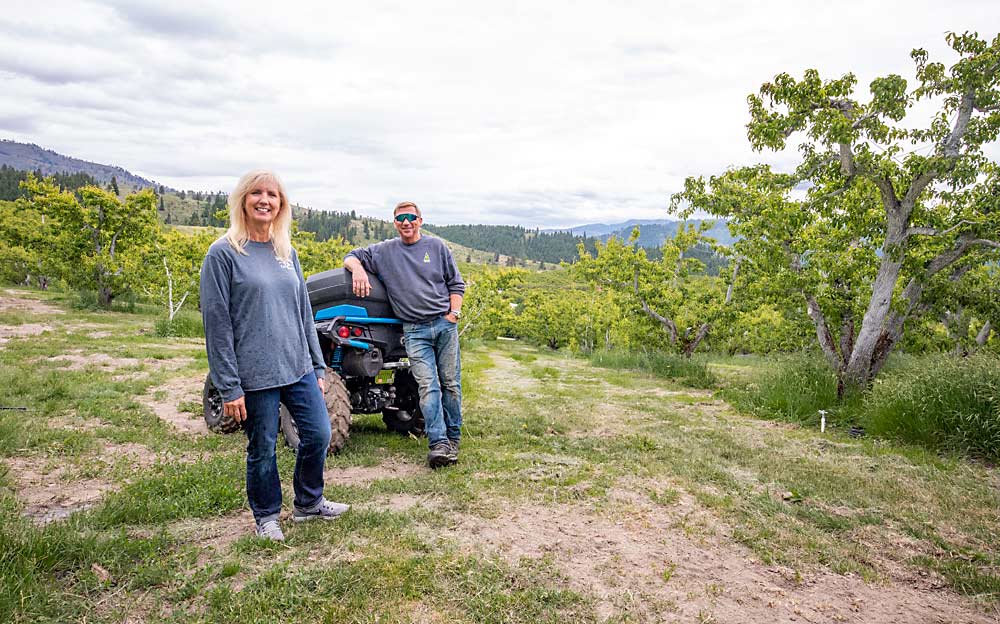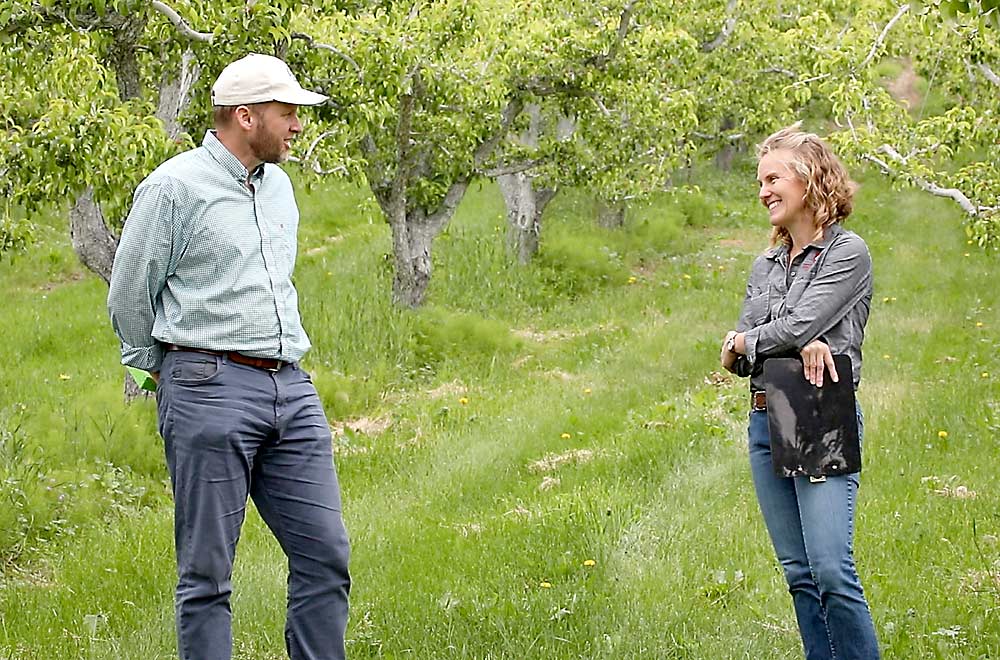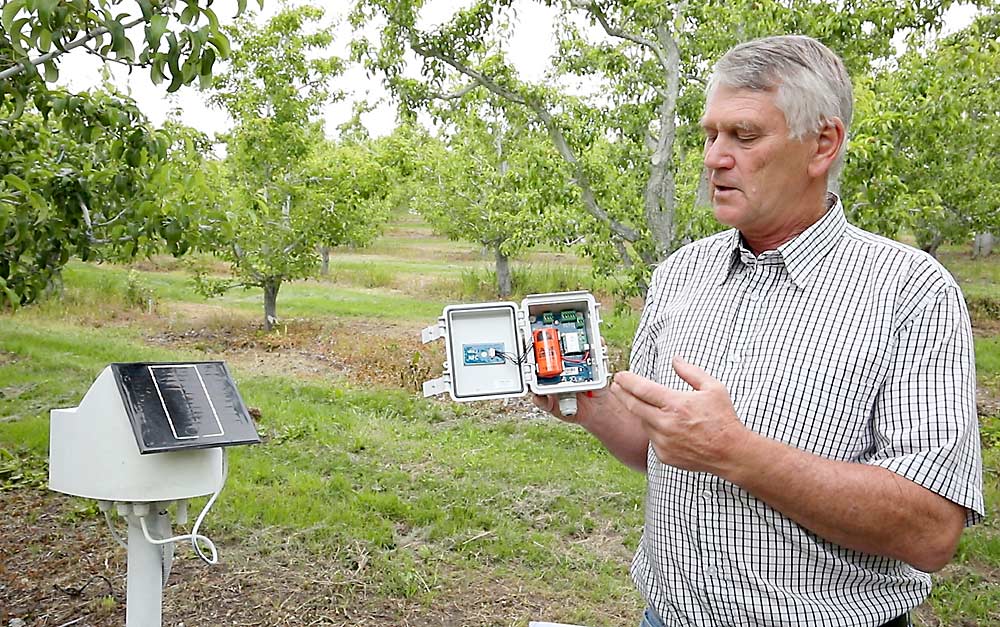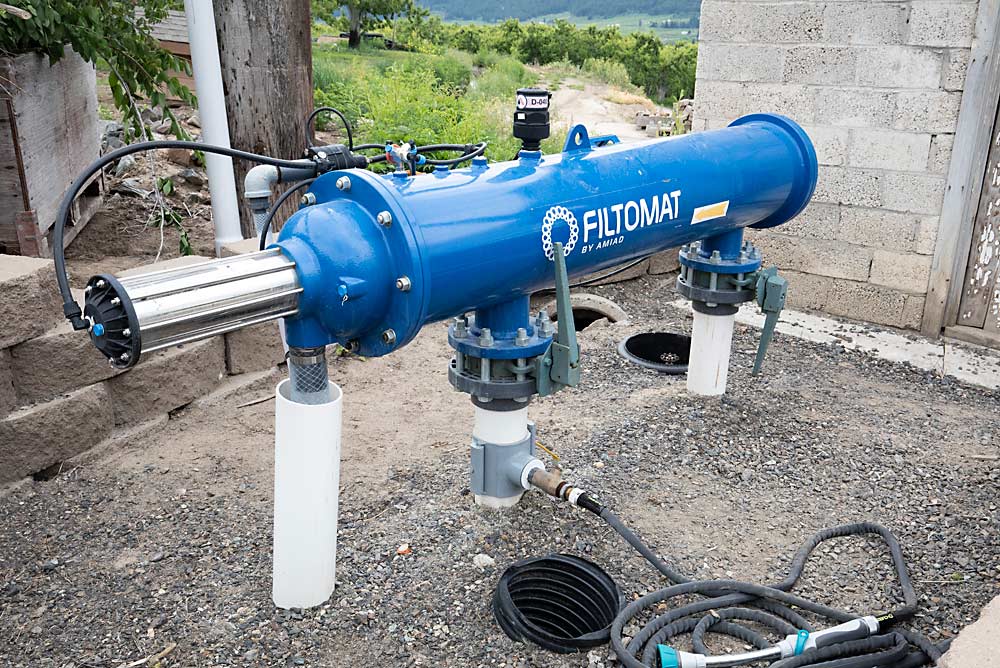
Cork spot cuts into packouts and poses a perennial problem for Anjou growers, but recent on-farm demos at several sites in Central Washington show that improving irrigation efficiency can significantly reduce culls due to cork and boost fruit size, subsequently boosting returns.
The irrigation upgrade blocks are part of a two-pronged research project led by Washington State University physiologist Lee Kalcsits, extension specialist Tianna DuPont and soil scientist Troy Peters, funded by the Washington Tree Fruit Research Commission. Support from conservation organizations also helped cover the cost of more efficient irrigation equipment.
“We’re trying to address two questions at once: What actually is our irrigation recommendation for the best fruit quality, and given that recommendation, how can we have the systems to deploy that?” DuPont said. “We need both to fully optimize our pear systems.”
Common irrigation challenges include cork, small fruit, uneven pressure or flow, clogging filters, runoff, not enough water and too much water, DuPont said.

In a virtual field day this summer, Kalcsits said that applying the right amount of water helps to keep trees in balance. Too much water encourages vigorous shoot growth that reduces light and spray penetration and promotes development of cork. On the other hand, making sure the entire block gets sufficient water can improve uniformity in fruit size.
His research trials, designed to better define irrigation recommendations for Northwest pear growers, are collecting a third season of data this harvest, so Kalcsits said he expects to have more specifics to share next year.
But even before those guidelines are released, DuPont said many growers with problem blocks can benefit from irrigation upgrades.
“I think we can see, in the near term, more pear growers looking to their irrigation to gain better and more consistent fruit quality,” she said. “We have better information and the tools are becoming more available.”
Dryden growers Larry and Renee Caudle said the project helped them see the value of upgrading their irrigation infrastructure. They volunteered an Anjou orchard on a sloping site where running a full set resulted in runoff, but dry spots persisted and impacted fruit size, Larry Caudle said in a virtual field day video.
Using a soil moisture sensor can help diagnose such problems, said Jac Le Roux, an irrigation consultant.

“You might think, when it’s running off, it’s full,” he said. “You could actually have a combination of the water running out of your block and stress due to the subsoil being dry. The solution is obvious: You want to change your irrigation design and put in a sprinkler system, like an R10, that puts the water on slow enough.”
After an irrigation audit with WSU experts, that’s exactly what the Caudles did. They replaced older impact sprinklers on a 36-foot-square spacing to microsprinklers at 20 by 20. They also had to upgrade the water filter to accommodate the microsprinklers.
Since the demonstration project in their 8-acre orchard block was part of the larger trial, the costs were supported by the Bonneville Environmental Foundation and the research commission, facilitated by WSU Extension and the Cascadia Conservation District. Over two seasons, the system cut their water use almost in half.
“The uniformity of the watering is fantastic compared to the old system,” Larry Caudle said. “The trees look better. We noticed a difference in how the trees looked in the first year, and we’re excited to see in the next several years what it’s going to look like.”
Fruit size increased about one size overall, Renee Caudle said, improving their returns.
“I think the increase in returns would pay for the new system in just a couple years — definitely worth it,” she said.

For another grower battling cork in a Cashmere, Washington, orchard, the solution didn’t involve new infrastructure. Brandon Long simply had to hand over his irrigation decision-making to a soil moisture sensor.
In recent years, the Anjou block struggled significantly with cork. “We didn’t even pick in 2017, it was that bad,” Long said.
Soil moisture sensors help irrigators stay within the optimum zone between field capacity and water stress, Peters said.
“We don’t want to put more water on the soil than it can hold. Then we wasted our time, we wasted our money, and we probably washed a lot of our valuable nutrients out of the soil,” he said.
Over time, the trees start to pull water out of the soil until “the water is so depleted that the roots have to work really hard to pull the water away from the soil. It begins to experience water stress,” Peters said.
Long had two soil moisture sensors installed, one in a control block and one in the experimental block. Both were located midslope in average soil moisture spots, he said. It was clear to see when he looked at the sensor data on the computer that the control block was continuously saturated, but it seemed unnatural to hold off on irrigating the experimental block as long as he did.
“Knowing the water was causing a problem and we needed to change something, I was OK with sticking with the program,” Long said. “I’m glad I didn’t get nervous and stuck with it, because it made a big difference in just one year.”
He used about 10 percent less water across the season, but the packout improved from 70 percent in the standard block to 79 percent, Long said.
The experiences of both Long and the Caudles, and growers in two other ongoing case studies, show how older pear blocks can benefit from irrigation advancements, DuPont said. Growers don’t have to renew entire blocks to take advantage of irrigation advancements, but they also may face more hurdles.
“It’s both the age of the blocks and the irrigation systems, but also the location and dispersal of the blocks, mean we tend to have challenges that need to be addressed to adopt precise irrigation management,” she said. “But we can document that this can make you money.”
It’s easy to calculate that return on investment in sensors or new sprinkler systems when you have a clear irrigation problem that can be solved, DuPont said. Better water management also offers benefits to fruit quality that may be harder to measure but even more significant for the pear industry long term. That’s what Kalcsits’ forthcoming research aims to shed light on as well.
The Cascadia Conservation District has cost-sharing capacity for Central Washington growers considering similar projects, DuPont said, and interested growers can contact her about irrigation assessment, too. •
—by Kate Prengaman






Leave A Comment